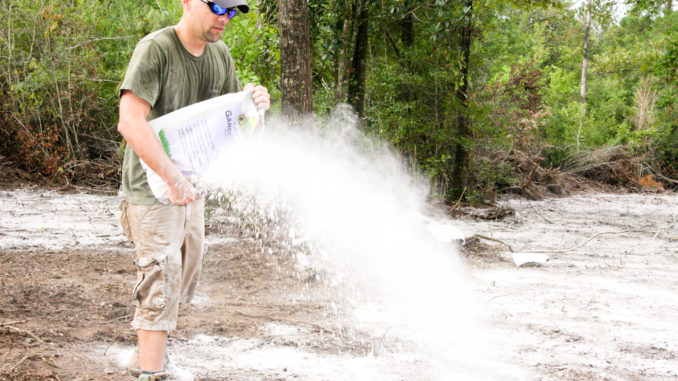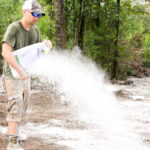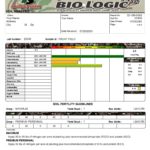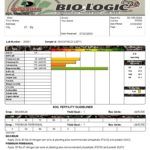
After three years of implementing food plots to attract deer, these “Postage Stamp Plots” featured in the August 2009 and 2010 issues of Louisiana Sportsman may finally become the tools that not only attract deer, but holds them on my property as well.
That’s because after three years of stubbornly refusing to do a soil sample, I finally took the grand total of one hour to collect soil from the plots, bag it up and fill out the required paperwork. I would finally have the proof that we didn’t need to add all that lime… or so I thought.
The entire process was made simple and painless through downloadable instructions and forms at the Mossy Oak Biologic web site. On August 7, I gathered soil at both plots by collecting and mixing soil from 10 to 15 spots on each plot. And to ensure nothing skewed my results, I collected the soil with a plastic gardening spade and mixed the soil in a plastic container
Mixing the soil from several areas in one plot provides an average that evens out all the variants that could change the pH from one side of the plot to the other. This allows the soil testers, in this case Biologic, to provide results that give a better overall recommendation as to what to add to the soil.
The soil was mailed to Biologic on Monday, August 9, and the results of the tests were emailed back to me by Thursday, August 12. The results were shocking.
All this time we had been plowing, harrowing, fertilizing and planting had produced some food plots that had seemingly done their jobs. However, it turns out that much of the fertilizer we spread on the plots wasn’t making its way into the forage. That is the importance of adding lime to bring up the pH.
The ph of the soil is a measurement of how acidic or alkaline the soil is. The lower the number the more acidic, and the higher the number the more basic. Most food sources that people grow in food plots do best around a neutral pH of 7.0.
However, recent conversations with some experts have convinced me Louisiana dirt, even in the most fertile regions, isn’t going to be close to a pH of 7.0, especially if it’s dirt that’s recently been exposed from under thick forests.
Getting the pH right for the specific crop you’re planting means that all the nutrients that are locked up in the soil, even those from your fertilizer applications, would now be available for your plants. That means your plants are going to be more succulent and more nutritious, which means these plants will attract more deer.
According to former Louisiana Department of Wildlife and Fisheries Deer Program Leader Dave Moreland, getting the right pH is crucial because it allows hunters to see a much better use of their plots.
Out of four soil tests, the only one that was anywhere close to 7.0 was a plot we have been working on for three years. It came back with a pH of 6.4, so we’re getting close to the point that we can plant just about anything we want to on this plot.
However, the second plot, which was recently annexed into a much larger series of lanes and plots, got caught up in the newly exposed ground, the best of which came back at 5.1 and the worst at 4.6.
Thankfully, these plots aren’t so large that we don’t have to spread tons of lime on them even though Biologic recommended as much as 5,000 per acre to get the soil right to plant clover.
Rather than bring in the lime truck, we decided to go with the country boy calibration and spreader and slung 35 40-pound sacks of lime by hand on just one plot the weekend before last because we were looking for “good enough” rather than perfection. But did we spread it early enough in front of our planting?
“That’s one thing about lime; It doesn’t work like fertilizer,” said Tom Ragan of Ragan and Massey, Inc., owners of PlotSpike brand of wildlife products. “It takes time for it to do its thing. Putting lime down in the fall is really too late.”
However, according to Moreland, putting down lime a month before planting is a lot better than putting it down at the time of planting. He said putting out lime with seed makes the lime just about worthless for that hunting season.
We covered two more plots this past weekend so we could at least try to make a difference for this hunting season. So if you’ve got a little plot you’ve been trying to grow, pull some soil today, mail it to Biologic so you can have your results by the middle of next week, and you can get some lime down next weekend.
If it doesn’t do much for you this year, you can expect to grow lush food plots next season, and that’s going to lead to better hunting.
Visit http://www.mossyoakbiologic.com/content.asp?ID=565§ion=pm to learn more about the Biologic soil testing process, and visit http://www.plotspike.com/ to learn more about PlotSpike seeds.







